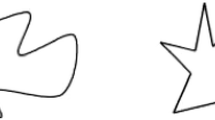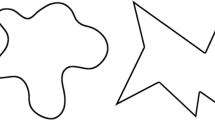Abstract
Twelve English- and 12 Urdu-speaking males, ranging in age from 18 to 30 years, were asked to assign pure-tone frequencies as a “best fit” to visually presented shapes. Six basic figures were employed (circle, ellipse, right triangle, isosceles triangle, along with two historical psycholinguistic forms—uloomu and takete) and varied on three dimensions of size, complexity, and density. The results of the study indicate that there was consistency in the assignment of pure-tone frequencies to the dimensions of the figures and that the pattern of assignment was generally similar for both English- and Urdu-speaking subjects alike. Specifically, for both language groups, round figures (circles and ellipses) were assigned significantly lower frequencies than other stimuli. Also, complex and dense figures (i.e., those designed to simulate “visual depth” and “visual texture,” respectively) received significantly higher frequency settings than those stimuli not possessing these dimensions. Additional analyses revealed several factors that may have contributed to the observed pattern. For example, Urdu subjects of high English proficiency produced frequency assignments that closely resembled those of the English-speaking subjects, while subjects of low English proficiency produced a pattern that was somewhat different, particularly with regard to round, complex figures. Length of residency in the United States (6 months, 1 year, or 2 years), however, did not significantly influence frequency assignments for the Urdu subjects. These results are discussed in terms of “cross-cultural” versus “language-specific” phonetic symbolism.
Similar content being viewed by others
References
Atzet, J., & Gerard, H.B. (1965). A study of phonetic symbolism among native Navajo speakers.Journal of Personality and Social Psychology, 1, 524–528.
Brown, R. (1958).Words and things. Glencoe, Illinois: Free Press.
Brown, R.W., Black, A.H., & Horowitz, A.E. (1955). Phonetic symbolism in natural languages.Journal of Abnormal and Social Psychology, 50, 388–393.
Davis, R. (1961). The fitness of names to drawings: A cross-cultural study in Tanganyika.British Journal of Psychology, 52(3), 259–268.
Dogana, F. (1983).Suono e senso: Fondamenti teorici ed empirici del simbolismo fonetico. Milan, Itlay: Franco Angeli Editore.
Duncan, D.B. (1955). Multiple range and multipleF tests.Biometrics, 11, 1–42.
Fischer-Jorgensen, E. (1978). On the universal character of phonetic symbolism with special reference to vowels.Studia Linguistica, 32(1–2), 80–90.
Gulick, W.L. (1971).Hearing: Physiology and Psychophysics. New York: Oxford University Press.
Irwin, W.F., & Newland, E. (1940). a genetic study of the naming of visual figures.Journal of Psychology, 9, 3–16.
Jespersen, O. (1922).Language: Its nature, development and origin. London: Allen and Unwin.
Keppel, G. (1982).Design and analysis: A researches handbook. Englewood Cliffs, New Jersey: Prentice-Hall.
Klank, L.J., Huang, Y.H., & Johnson, R.C. (1971). Determinants of success in matching word pairs in tests of phonetic symbolism.Journal of Verbal Learning and Verbal Behavior, 10, 140–148.
Malberg, B. (1964). Couches primitives de structure phonologique.Phonetica, 11, 221–222.
Maltzman, I., Morrisett, L., Jr., & Brooks, J. (1956). An investigation of phonetic symbolism.Journal of Abnormal and Social Psychology, 53, 249–251.
Miron, S. (1961). A cross-linguistic investigation of phonetic symbolism.Journal of Abnormal and Social Psychology, 62, 623–630.
Molino, J.A. (1973). Pure tone equal-loudness contours for standard tones of different frequencies.Perception and Psychophysics, 1, 1–4.
Newman, S. (1993). Further experiments in phonetic symbolism.American Journal of Psychology, 45, 53–75.
O'Boyle, M.W., & Tarte, R.D. (1980). Implications for phonetic symbolism: The relationship between pure tones and geometric figures.Journal of Psycholinguistic Research, 9, 535–544.
Orr, J. (1944). On some sound values in English.British Journal of Psychology, 35, 1–8.
Osgood, C.E. (1960). Cross-cultural generality of visual-verbal synesthetic tendencies.Behavioral Science, 5, 149–169.
Sapir, E. (1929). A study in phonetic symbolism.Journal of Experimental Psychology, 12, 225–239.
Tarte, R.D. (1974). Phonetic symbolism in adult native speakers of Czech.Language and Speech, 17, 87–94.
Tarte, R.D. (1976).Phonetic symbolism for pure-tones. Paper presented at a meeting of the Psychonomic society, St. Louis.
Tarte, R.D. (1982). The relationship between monosyllables and pure tones: An investigation of phonetic symbolism.Journal of Verbal Learning and Verbal Behavior, 21, 352–360.
Tarte, R.D., & Barritt, L.S. (1971). Phonetic symbolism in adult native speakers of English: three studies.Language and Speech, 14, 158–168.
Tarte, R.D., & O'Boyle, M.W. (1982). Semantic judgments of compressed monosyllables: Evidence for phonetic symbolism.Journal of Psycholinguistic Research, 11, 183–196.
Taylor, I.K. (1963). Phonetic symbolism re-examined.Psychological Bulletin, 60, 200–209.
Taylor, I.K. (1976).Introduction to psycholinguistics. New York: Holt, Rinehart & Winston.
Taylor, I.K., & Taylor, M.M. (1962). Phonetic symbolism in four unrelated languages.Canadian Journal of Psychology, 16, 344–356.
Taylor, I.K., & Taylor, M.M. (1965). Another look at phonetic symbolism.Psychological Bulletin, 64, 413–427.
Author information
Authors and Affiliations
Rights and permissions
About this article
Cite this article
O'Boyle, M.W., Miller, D.A. & Rahmani, F. Sound-meaning relationships in speakers of Urdu and English: Evidence for a cross-cultural phonetic symbolism. J Psycholinguist Res 16, 273–288 (1987). https://doi.org/10.1007/BF01067547
Accepted:
Issue Date:
DOI: https://doi.org/10.1007/BF01067547




